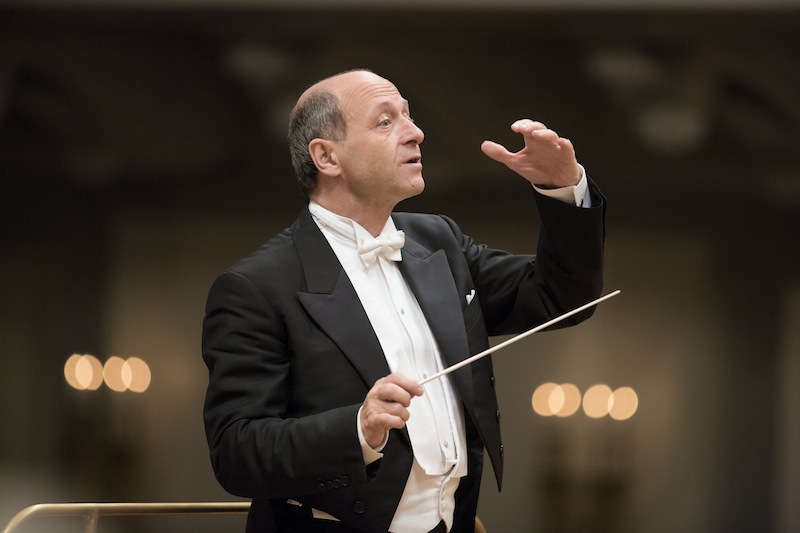Budapest Festival Orchestra presents a dark, Old World sonority at Carnegie

Iván Fischer conducted the Budapest Festival Orchestra at Carnegie Hall Thursday night. File photo: Marco Borggreve
Iván Fischer brought his Budapest Festival Orchestra to Carnegie Hall Thursday night with an assortment of favorites: the Overture to Weber’s Der Freischütz, Liszt’s Piano Concerto No. 1 and Prokofiev’s Symphony No. 5. In this “Carnegie Classics” event, the theme, if any, was simple musicianship. And while the orchestra played quite well, the concert was not completely fulfilling.
The ensemble, cultivated by Fisher, is currently unique on the classical scene in that they play modern instruments and yet make an old-fashioned sound. This is due partly through stage arrangement–with cellos and violas in the middle and basses on a riser in back–and partly through their Central European colors, like the wonderfully nasal oboe.
But the predominant feature of their sound is achieved by how they play, how they approach phrasing and how the ensemble works together. They eschew the glossy exactitude of accents, rhythms, and phrases that are commonplace with most other orchestras. This doesn’t mean they’re sloppy—they play together coherently, but value the warmth and complexity of their corporate sound above all else.
The sonority is warm with the colors of nature: earth, bark, moss. But that sound and the manner of playing—in technique close to Furtẅangler’s way with music, though far from it in spirit—were not ideal for everything on the program.
The Weber overture was the most successful meeting of composition and orchestra. Fischer enhanced the drama of the music by splitting the horns and placing them standing in pairs on each side of the orchestra, where their opening chorale became a ceremonial fanfare. The pace was deliberate, drawing attention to narrative, and the orchestra gave the music an astoundingly dark and rich color. Few performances of this overture convey such weight and dark intensity.
The orchestra was eager and agile accompanying Marc-André Hamelin in the Liszt piano concerto, but the pianist was the star. His touch at the keyboard was explosive or silky, depending on the demands of the moment. There was a brightness and a smoothness to his playing that sat well against the accompaniment.
The concerto unites both parties in on-going, cyclic variation, but it also pits two characters against each other—cool piano and eccentric orchestra. They connect marvelously through the strange and wonderful triangle part in the last two movements. Fischer made this explicit by seating the percussionist upfront, just behind Hamelin’s left shoulder.
Hamelin’s ease in playing this piece was not showy, but made the music sing. His encore, Liszt’s transcription of the “My Darling” song from Chopin’s Op. 74 Six chants polonais, was modest, lovely, and charming.
After intermission, the Prokofiev symphony came off oddly. The orchestra played with substantial energy and power, and handled all the technical challenges, but the result was at times a good simulation of Prokofiev, rather than the real thing. The blend of instruments, which sounded so convincing in Weber and Liszt, tended to smooth over the composer’s angles and dilute his tart sonorities.
There was also a surprising lack of wit. The overall mood of the symphony is serious and lyrical, a “hymn to free and happy Man,” in Prokofiev’s words, made during the apocalyptic denouement of World War II. But he sets that spirit into greater relief through characteristic sarcasm, especially in the impish scherzo theme and the main tune in the finale, which is marked giocoso. Fischer and the orchestra’s method was to keep the music propulsive but heavy, as if seeking a deeper transformation. That’s a valid goal, but it didn’t succeed.
The orchestra’s encore seemed to be part of another concert entirely. All the musicians stood and, holding the music in their hands, sang what Fischer described as a “4th century Russian church song arranged by a 19th-century composer.” It was a special musical moment, with singing that was sweet and luminous.






Posted Feb 19, 2016 at 10:21 pm by Howard Marder
Were we at the same concert? Apparently the audience (which gave the Budapest a standing ovation) had a totally different point of view about this wonderful group. A great orchestra and a great conductor. Wish that we could hear them here more often.